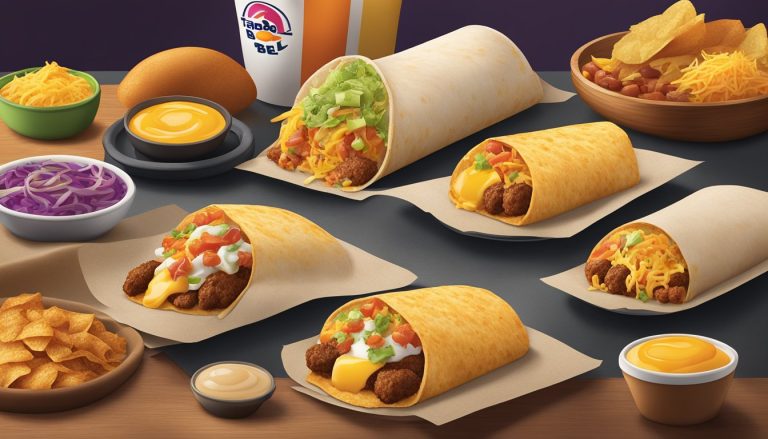Taco Bell’s foray into the breakfast market in 2013 marked a significant expansion for the fast-food chain. This move aimed to tap into a new meal occasion with tremendous potential for growth and increased revenue. The company’s decision to introduce breakfast items came after previous unsuccessful attempts, highlighting the challenges and opportunities in this competitive space.
Taco Bell’s breakfast menu pricing strategy balances affordability with profit margins, typically offering items at $1-$3 to attract cost-conscious consumers while maintaining healthy returns. This approach allows the company to compete effectively with established breakfast players like McDonald’s and Burger King. The economics of Taco Bell’s breakfast rely on leveraging existing kitchen equipment and staff during previously underutilized morning hours, maximizing operational efficiency.
The success of Taco Bell’s breakfast initiative hinges on factors such as menu innovation, marketing effectiveness, and operational execution. By offering unique items that align with its brand identity, Taco Bell aims to differentiate itself in the crowded breakfast market. The company’s ability to manage food costs, labor expenses, and overhead while delivering value to customers will ultimately determine the profitability of its breakfast venture.
Taco Bell’s Entry into the Breakfast Market

Taco Bell’s foray into the breakfast market marked a significant expansion of its menu offerings and business strategy. The move aimed to tap into a new customer base and revenue stream by capitalizing on the growing trend of fast-food breakfast consumption.
Conceptualizing the Breakfast Opportunity
Taco Bell identified breakfast as a lucrative market segment with substantial growth potential. The company recognized that consumers were increasingly purchasing breakfast meals outside the home, creating an opportunity to capture market share.
Taco Bell’s brand identity and existing customer base provided a foundation for introducing unique breakfast options. The company aimed to differentiate itself from competitors by offering Mexican-inspired breakfast items that aligned with its core menu concept.
Market research played a crucial role in shaping Taco Bell’s breakfast strategy. The company analyzed consumer preferences, eating habits, and competitors’ offerings to develop a compelling value proposition for its breakfast menu.
The Launch of Taco Bell’s Breakfast Menu
Taco Bell officially launched its breakfast menu in 2014, introducing a range of innovative items. The menu featured products such as the Waffle Taco, A.M. Crunchwrap, and Cinnabon Delights.
The company invested heavily in marketing campaigns to promote its new breakfast offerings. Taco Bell leveraged social media, television commercials, and in-store promotions to create buzz and attract customers.
Pricing strategies were carefully considered to ensure competitiveness while maintaining profit margins. Taco Bell positioned its breakfast items as affordable alternatives to traditional fast-food breakfast options.
Analyzing the Breakfast Line Success
Initial consumer response to Taco Bell’s breakfast menu was largely positive. The unique flavor profiles and convenient options resonated with many customers, particularly younger demographics.
Sales data indicated a promising start for the breakfast line. Taco Bell reported increased foot traffic during morning hours and a boost in overall revenue following the launch.
Challenges emerged as the company fine-tuned its breakfast operations. Taco Bell had to address issues such as staff training, inventory management, and streamlining kitchen processes to handle the new menu items efficiently.
The breakfast menu’s performance varied across different locations. Urban areas and regions with higher fast-food breakfast consumption generally saw stronger sales compared to rural locations.
Understanding the Target Audience
Taco Bell’s breakfast strategy hinges on appealing to a specific demographic with tailored menu offerings and pricing. The fast-food chain aims to capture market share by aligning its breakfast items with consumer preferences and behaviors.
Identifying Taco Bell’s Target Customers
Taco Bell’s primary breakfast target audience consists of young adults, particularly those aged 18-24. This group forms a crucial segment for quick-service restaurants, with Taco Bell relying heavily on their patronage for sales and revenue.
The brand also focuses on single young men, who often seek convenient and affordable meal options. Millennials represent another key demographic, drawn to Taco Bell’s emphasis on creativity and individuality in its menu and marketing.
Consumer Behavior and Preferences
Taco Bell’s breakfast customers typically prioritize value, convenience, and unique flavors. They tend to be on-the-go individuals looking for quick, satisfying meals to start their day.
These consumers often appreciate innovative menu items that blend traditional breakfast fare with Taco Bell’s signature Mexican-inspired cuisine. Popular choices include breakfast burritos and tacos with eggs, cheese, and various protein options.
Coffee remains an essential component of the breakfast experience for many customers. Taco Bell has integrated coffee offerings to meet this demand and compete with other fast-food breakfast providers.
The target audience also shows a preference for customizable options and combo meals that offer perceived value. This aligns with Taco Bell’s strategy of providing affordable, tasty food as a key part of its value proposition.
Menu Composition and Innovation

Taco Bell’s breakfast menu represents a bold foray into new territory for the fast-food chain. The company leveraged its existing brand identity while introducing novel breakfast items tailored to morning customers.
From Doritos Locos Tacos to Waffle Tacos
Taco Bell’s breakfast innovation drew inspiration from its successful Doritos Locos Taco line. The company applied a similar creative approach to develop unique breakfast offerings. The Waffle Taco emerged as a signature item, featuring a folded waffle filled with scrambled eggs, cheese, and a choice of bacon or sausage.
This product exemplified Taco Bell’s strategy of combining familiar breakfast elements with its Tex-Mex identity. The innovation extended to other items like the A.M. Crunchwrap, which adapted the popular lunch/dinner item for morning consumption.
Expanding Beyond Traditional Tex-Mex
Taco Bell’s breakfast menu expansion went beyond typical Tex-Mex fare. The company introduced items that appealed to a broader breakfast audience while maintaining its brand essence.
Grilled breakfast burritos and quesadillas offered more conventional options with a Taco Bell twist. The menu also included hash browns, providing a familiar breakfast staple to attract customers seeking traditional morning fare.
This diversification aimed to capture a wider market share by catering to various breakfast preferences.
Highlighting Signature Breakfast Items
Taco Bell developed several standout items to differentiate its breakfast offerings. The Breakfast Crunchwrap became a flagship product, combining scrambled eggs, hash brown, cheese, and meat in a grilled tortilla.
Cinnabon Delights, a collaboration with the popular cinnamon roll chain, added a sweet option to the menu. These warm, cream-filled pastries provided a unique dessert-like breakfast choice.
Taco Bell also introduced breakfast versions of its popular nachos, further bridging its core identity with morning meal expectations. These signature items aimed to create a distinct breakfast experience that set Taco Bell apart from competitors.
Operational Strategy and Challenges

Taco Bell’s breakfast initiative required careful planning and execution to overcome unique operational hurdles. The company faced challenges in adapting its kitchen processes, training staff, and maintaining consistency across franchises.
Addressing Operational Issues
Taco Bell revamped its kitchen layouts to accommodate new breakfast equipment. The company invested in specialized toasters and griddles to prepare items like the Waffle Taco and A.M. Crunchwrap. Staff training programs focused on efficient breakfast preparation during early morning hours.
Inventory management posed another challenge. Taco Bell had to source new ingredients and develop storage solutions for perishables like eggs and bacon. The company implemented just-in-time delivery systems to ensure freshness and minimize waste.
Taco Bell also adjusted its staffing model. Restaurants needed to open earlier, requiring new shift schedules and additional labor costs. Some locations hired dedicated breakfast teams to maintain service speed during the morning rush.
Maintaining Consistency Across Franchises
Yum! Brands, Taco Bell’s parent company, developed strict guidelines for franchisees to ensure a uniform breakfast experience. These standards covered everything from food preparation techniques to marketing materials.
Taco Bell provided comprehensive training materials and on-site support to help franchises implement the breakfast menu. The company also conducted regular quality audits to maintain consistency.
To incentivize franchise participation, Taco Bell offered financial support for equipment upgrades and marketing campaigns. This helped offset initial costs and encouraged widespread adoption of the breakfast program.
Taco Bell created a feedback system for franchisees to report operational issues and suggest improvements. This collaborative approach helped refine processes and menu offerings over time.
Pricing Strategies and Profit Margins

Taco Bell’s breakfast menu pricing and profit margins are carefully calculated to balance competitive positioning with financial viability. The fast food chain employs strategic pricing models and cost management techniques to maximize profitability in the crowded breakfast market.
Evaluating Taco Bell’s Pricing Model
Taco Bell utilizes value-oriented pricing for its breakfast items. Many menu options are priced just under whole dollar amounts, like $0.99 or $1.99. This psychological pricing taps into consumer perceptions of affordability.
The chain also employs tiered pricing across its breakfast menu. Lower-priced items appeal to budget-conscious customers, while premium options target those willing to spend more. This segmented approach allows Taco Bell to capture different consumer groups.
Promotional pricing is used strategically to drive traffic and boost sales. Limited-time offers and combo deals incentivize customers to try new items or increase their order size.
Maximizing Profit Margins
Taco Bell focuses on efficient operations to maintain healthy profit margins. The chain leverages its existing kitchen equipment and ingredients to minimize additional breakfast-specific costs.
Bulk purchasing power through parent company Yum Brands helps reduce ingredient costs. Standardized cooking processes and portion control also contribute to consistent food costs across locations.
Menu engineering plays a key role in profitability. High-margin items are strategically placed and promoted to encourage their selection. Lower-margin offerings often serve as entry points to upsell customers to more profitable options.
Labor costs are managed through cross-training staff to handle breakfast shifts. This flexibility allows for efficient scheduling and helps control payroll expenses during slower morning hours.
Competing in the Fast Food Breakfast Space
Taco Bell positions its breakfast menu as a unique value proposition in the fast food market. The chain differentiates itself with Mexican-inspired breakfast items that stand out from traditional offerings.
Price competitiveness is crucial in the breakfast segment. Taco Bell aims to undercut or match prices of key competitors like McDonald’s and Burger King to attract price-sensitive morning customers.
The chain emphasizes its “Breakfast Value Menu” to compete on affordability. This strategy targets budget-conscious consumers who prioritize low prices in their morning meal choices.
Innovation in menu items and limited-time offers helps Taco Bell stay relevant in the competitive breakfast space. New products generate buzz and give customers reasons to choose Taco Bell over familiar alternatives.
Marketing and Promotional Tactics
Taco Bell’s breakfast menu launch relied heavily on targeted advertising and enticing promotions. These strategies aimed to attract customers and establish the brand’s presence in the competitive breakfast market.
The Role of Advertising Campaigns
Taco Bell’s breakfast advertising campaigns focused on differentiating their offerings from competitors. The fast food chain emphasized unique menu items like the Waffle Taco and A.M. Crunchwrap. They used bold, eye-catching visuals and humorous commercials to capture attention.
Social media played a crucial role in spreading awareness. Taco Bell leveraged platforms like Twitter and Instagram to engage younger audiences. The company also partnered with influencers to create buzz around their breakfast menu.
Television ads featured prominently during morning shows and prime-time slots. These commercials often highlighted the convenience and affordability of Taco Bell’s breakfast options.
Leveraging Promotions and Deals
Taco Bell implemented various promotional tactics to drive traffic and encourage trial of their breakfast items. The chain offered free breakfast items during specified hours to generate interest and word-of-mouth marketing.
Limited-time offers, such as discounted combo meals, incentivized customers to visit during breakfast hours. Taco Bell also introduced loyalty program rewards specifically for breakfast purchases.
The company partnered with delivery services to offer exclusive breakfast deals. This strategy catered to customers seeking convenient morning meal options.
Seasonal promotions, tied to holidays or events, helped maintain excitement around the breakfast menu. These time-sensitive offers created a sense of urgency and encouraged repeat visits.
Analyzing the Competitive Landscape

Taco Bell’s entry into the breakfast market faces intense competition from established players. A comprehensive analysis reveals the brand’s strengths and challenges in this new segment.
SWOT Analysis of Taco Bell’s Breakfast
Strengths: Taco Bell’s strong brand recognition and existing customer base provide a solid foundation for breakfast expansion. The chain’s innovative menu offerings, like the Breakfast Crunchwrap, differentiate it from competitors.
Weaknesses: Limited breakfast experience compared to rivals like McDonald’s and Starbucks. Taco Bell’s Mexican-inspired menu may not appeal to traditional breakfast consumers.
Opportunities: Growing demand for convenient, affordable breakfast options. Potential to capture market share from price-sensitive consumers seeking alternatives to coffee shop fare.
Threats: Intense competition from established breakfast chains and fast-food rivals. Economic fluctuations affecting consumer spending habits on dining out.
Studying Competitive Forces and Advantages
Porter’s Five Forces analysis reveals high competitive rivalry in the breakfast segment. Taco Bell faces pressure from substitutes like home-cooked meals and on-the-go options.
Key competitive advantages:
- Unique menu items blending Mexican and American flavors
- Competitive pricing strategy targeting value-conscious consumers
- Extensive network of locations for convenient access
Challenges:
- Building consumer trust in breakfast quality
- Differentiating from established breakfast brands
- Adapting marketing to highlight breakfast offerings
Market research indicates a growing preference for all-day breakfast options, presenting an opportunity for Taco Bell to leverage its late-night popularity into morning sales.




